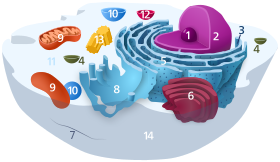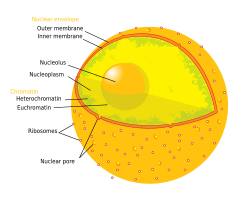
Back Selkern Afrikaans Zellkern ALS Nuclio celular AN نواة (خلية) Arabic Nucleu celular AST Hüceyrə nüvəsi Azerbaijani Күҙәнәк ядроһы Bashkir Клетачнае ядро Byelorussian Ядро вузы BE-X-OLD Клетъчно ядро Bulgarian



The cell nucleus (plural: cell nuclei) contains the cell's genes and controls the cell's growth and reproduction. It has a double layered nuclear membrane round it. The nucleus is usually the most prominent organelle in a cell. The nucleus is small and round, and works as the cell's control center. It contains chromosomes which house the DNA. The human body contains billions of cells, most of which have a nucleus.
All eukaryote organisms have nuclei in their cells, even the many eukaryotes that are single-celled. Bacteria and Archaea, which are prokaryotes, are single-celled organisms of a different type and do not have nuclei. Cell nuclei were first found by Antonie van Leeuwenhoek in the 17th century.
The nucleus has a membrane around it but the things inside it do not. Inside it are many proteins, RNA molecules, chromosomes and the nucleolus. In the nucleolus ribosomes are put together. After being produced in the nucleolus, ribosomes are exported to the cytoplasm where they translate mRNA into proteins.
When a cell is dividing or preparing to divide, the chromosomes become visible with a light microscope. At other times when the chromosomes are not visible, the nucleolus will be visible.